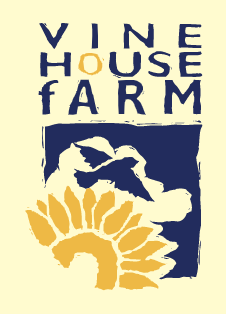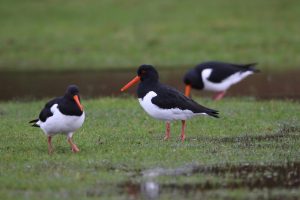
What looked like being a dry December has turned out to be a wet one, with over two inches in the past week. No doubt some of you will be thinking ‘is that all they had’? Our December rainfall was 67mm or 2.6ins which brings us up to nearly an average year – 523mm or 20.6ins. Our average rainfall over the past 47 years is 531mm or 20.9ins. December has been a bit colder than usual, which meant we were very busy getting bird seed out before Christmas. Quite simply if it gets cold we use more oil or gas, but the birds have to eat more to keep themselves warm.

On the farm we have been busy loading potatoes. There is always a good trade before Christmas, as most of us are not at work and so eat less sandwiches and more potatoes.
The other job that doesn’t stop at Christmas is loading sugar beet. It takes two or three days to shut a sugar beet factory and the same to get it going again, so the factory keeps processing every day over Christmas. Hauliers deliver every day except Christmas and New Years day. Gone are the days when we all used to have our own lorry, or tractor and trailer, to deliver our own crop. Today the hauliers will come with large loading machines, some of them can load 30 tons of sugar beet in three or four minutes. This type of giant loading machine is called a mouse, as it creeps along moving the entire heap into lorries, via a long elevator. The haulier will need at least 10 or 15 lorries to warrant having such a machine. It does tend to leave soil or mud on the road and so our cars here in the east do not stay clean for very long in the winter.
Our big crop of sugar beet means the four remaining sugar beet factories will be open until the end of March, or early April, later than ever before. This is ideal for British Sugar, but not for the farmer as we have to think about the next crop to go in the field where the sugar beet is. British Sugar would like their machinery working eight months of the year, instead of six months.
Fifty years ago there were 17 factories, opening mid September and closing by the end of January. Gradually 14 of those factories have closed and a new one built at Wissington, near Downham Market. We used to take our crop to Spalding by tractor and trailer, 17 tons at a time, which was by far the largest agricultural trailer on the road at the time. Spalding factory closed so we then took the crop to Peterborough. When Peterborough closed, it was time to think of using a haulier as Kings Lynn was our designated factory, 33 miles away.
The crop of organic stubble turnips we planted for seed for the second time won’t make a crop, due to the flea beetle. The field will be resown with spring barley when the weather is right, in March or April. Crop failures on the organic farm are rare, maybe one other crop failure in the 17 years we have been farming organically.
We had a good autumn, all our crops were sown in good conditions and are growing well but that doesn’t mean that we will get a good harvest. The quantity and quality of our harvest depends on the rain and sunshine we get in May – July. Every crop produces a good yield if there is plenty of sunshine when it is in flower but it also needs moisture to produce that good crop. The last time our crops were in such good order at this time of year was in 2012, but we had the worst harvest in living memory, due to the summer being a washout. There was plenty of moisture but no sunshine.


The family of birds that can take water to their young, is the Sand Grouse. Their habitat is desert and semi-desert in Africa and India; they are fast flying birds and will fly up to 50 miles to find water. They bathe in the water, don’t give themselves a good shake and fly back to their young which drink the water trapped in their feathers. Most Sand Grouse are a sandy colour so are not easy to see, but they can be seen in the drier areas of Spain. If only other species could achieve this, they would not be so reliant on insects during their breeding season.
We have seen most of our winter visitors now, but could see more arriving if we get another cold spell, or perhaps I should say if the continent gets a cold spell of weather. Our winter visitors travel south and west looking for food and frost free places, many places will be devoid of food but where there has been a good natural harvest they will stop and gorge themselves. When the food runs out in one place, they move further south and west and by February many of them are working their way north and east, looking for good food sources.
Our resident birds don’t have to put on extra weight, like our migrants who have to fly across the North sea or even the Atlantic Ocean to Iceland. They have to find food in their local area, which depends on the species. Wrens, Robins and Dunnocks will keep very local, not even venturing a mile. They have their own territory throughout the winter, not even sharing with their own species. The Tit family may well roam two or three miles, they go around in family parties which could be up to 40 strong. They visit lots of food sources during the day, so if one food source disappears it’s not a disaster. They feel there is safety in numbers; lots of eyes looking out for danger.
Finches and Buntings will roam several miles looking for food and they flock up when there is a good food source, such as our farm over the last 25 years. The contents of those flocks have changed. The biggest change has been the decline of the Corn Bunting, 25 years ago I would be feeding 300 Corn Buntings, today I am not feeding any; someone else is feeding a much reduced flock in Thurlby Fen. They, like other Buntings and Finches in Deeping Fen, have had a surplus of food all winter for those 25 years. This means their problems are during the summer, which I have been trying to redress.
This winter I am feeding hundreds of Chaffinches, Reed Buntings and Tree Sparrows in several locations. Also smaller numbers of Linnets, Yellowhammers, Goldfinches, Greenfinches and House Sparrows. I imagine that nearly all of the birds are local, except the Chaffinches. We do get Chaffinches from Scandinavia so perhaps some of them are from there.
Unfortunately our countryside is not rich enough to maintain the species on the red data list, such as Corn Buntings and Yellowhammers. The best solution is to hang a feeder of wheat or millet in each of their territories, from April through to August. We can’t expect farmers to do this, it is those of us who want to see these birds, and are interested, who should place a feeder in their local Yellowhammer territory.
Supplementary feeding has greatly improved my Tree Sparrow population. As soon as one brood is reared, the female is laying more eggs while the male is feeding the brood that has just fledged. Some of them get four successful broods in a good year. In ten years my Tree Sparrows have gone from three pairs to 150 pairs.
In the summer there were a lot of voles in the clover field but once the clover was harvested, the Herons had a field day catching voles, until it was ploughed. Now we have another field of clover, over a mile from the other one, which must be full of voles as there are about four Barn Owls that hunt over it. It is really amazing how wildlife can increase in the right conditions.
Events
Sun 21st January & Sat 3rd February:
Winter Bird Watch at Vine House Farm
Join us on our conservation award winning farm
to see many species of breeding birds
Tickets are £5 each – order online or call 01775 630208



